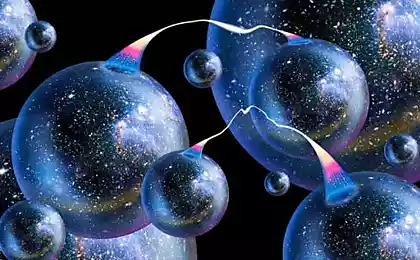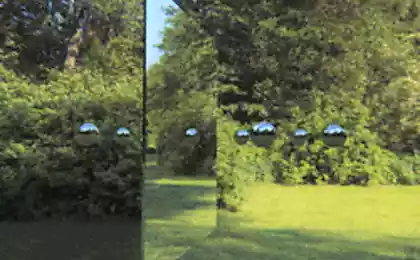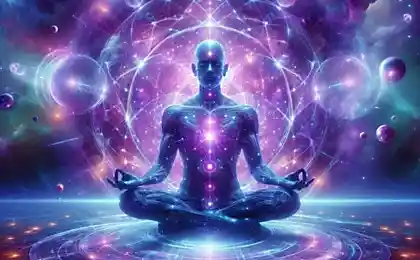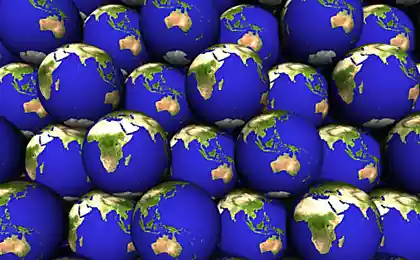594
Quantum mechanics is a strange realm of reality
Can the strange behavior of quantum particles to indicate the existence of other parallel universes? This question about five years ago asked bill Poirier, a Professor of chemistry at the University of Texas. However, when the bill had no idea that as the understanding of quantum mechanics to complex molecules it will fall down the rabbit hole and start looking for evidence of other parallel worlds, which may occur in our own at the quantum level.
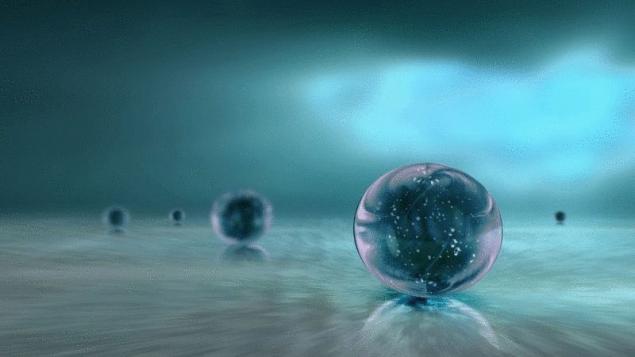
Professor of chemistry and biochemistry, Texas tech University says quantum mechanics is a strange realm of reality. Particles at the atomic and subatomic level can be in two places at the same time. Since the activity of these particles is so vague that scientists can describe it mathematically, "drawing" tiny landscape probability wave.
Chemists like Poirier draw these landscapes to better understand chemical reactions. Despite the "uncertainty" of the location of the particle, wave, quantum mechanics allows scientists to make accurate predictions. The rules are well known. At least were up until Poirier found a whole new way to picture the quantum landscapes. Instead of waves its environment have become parallel universes.
Although his theory, which he called the "many interacting worlds" sounds like science fiction, mathematically it is quite stable. First published in 2010, the theory has led to a number of invitations to read the report and publication in the Physical Review.
"The theory attracted a lot of attention in society, the fundamental mechanics and popular press, says Poirier. — At a Symposium in Vienna in 2013, standing five feet away from the famous Nobel laureate in physics, I gave a presentation of this work, expecting nothing but criticism. Surprisingly, it was not at all. In addition, I would be happy to see that my math was not obvious error."
In his theory Poirier suggests that small particles from many worlds seep through interaction with our, and this interaction is evident in the strange phenomena of quantum mechanics. This includes particles that supposedly exist in many places at the same time or can be interconnected over large distances.

In his theory there are no blurry moments. Particles occupy a clearly defined position in any specific world. However, from world to world, these positions vary, which explains why they may appear in several places. Similarly, quantum communication between distant particles which Einstein called "spooky action at a distance" — is due to the interaction of neighboring worlds.
The theory of "many interacting worlds" does not prove that quantum waves do not exist or that there exist many worlds. Standard wave theory works well in many cases and finds experimental confirmation.
"Our theory although it uses different mathematics, makes the same experimental predictions, he says. — All we've done is just admitted the possibility that quantum waves do not exist. Now she has exactly the same rights as a set of interacting worlds, no more and no less. And it may be the best explanation of the issues over which they fought the best minds of humanity for a hundred years."
In the nanometer scale particles do not behave like large objects, the position of which is well known for, like flying a plane or falling from the tree Apple. Instead, particles sometimes behave like fixed particles and sometimes as waves. Moreover, when scientists look at a quantum particle, they behave like particles. And when not looking, they suddenly become waves.
Even albert Einstein said that he doubted the quantum ideas that particles can exist in several places and not allowed to catch its own tail. "I like to think that the moon is there even when I'm not looking at it", said once by Einstein.
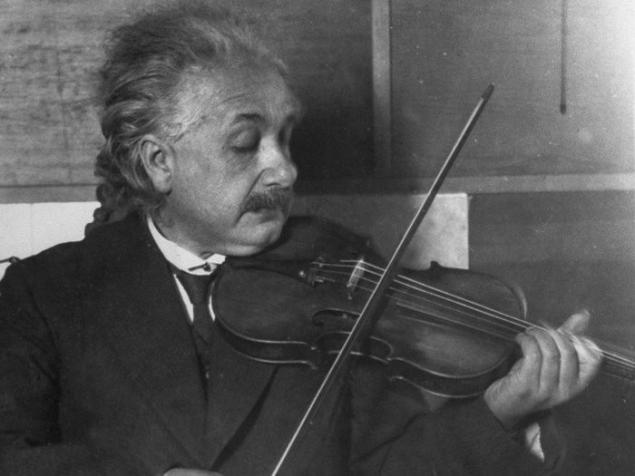
Scientists used the schrödinger equation, mathematical description, invented in the 20-ies of the last century, which shows the frantic motion of wave particles. At least showed, while Poirier't looked at the wave from the other side and not questioned this aspect of quantum theory. Some physicists can't think about quantum mechanics without its share of philosophy. However, as a chemist, Poirier is not particularly interested in philosophy and more — in the solution of Schroedinger's wave equation, which helps him to understand a chemical reaction.
"In physical chemistry we are interested in solving problems with large complex molecules, the most accurate way, he says. — We look at the flow rate of the chemical reaction, the allowed quantum States of the molecules and spectral fingerprint, which emits or absorbs the molecule. There is a paradox. To accurately answer these types of questions required quantum mechanics, but the solution of quantum mechanical problems for large systems (with more than three bodies) is extremely difficult."
Chemists use traditional methods based on mesh for solving the quantum wave equation. However, the more complex the molecule, the more difficult calculations. With each additional atom the necessary computing power is growing by around 10,000 times. To ease the computational load, chemists assembled at the engineers idea: let the grid points move like liquid flow with quantum wave. Moving the grid points are laid path, like a ball. If engineers use this technique to model the flow of a liquid, chemists use it to calculate the motion of quantum wave — hence comes the term "quantum hydrodynamics".
Poirier wonders what would happen if you removed wave computations and continued to work with quantum trajectories whether to run a simple numerical simulation?
"I just needed to understand that all you need is yourself moving quantum trajectory, he says. — To say your trajectory to move quantum wave is not needed. Trajectory decide it. You do not need this wave. The answer to any scientific question can be found, if you know how the wave motion and only one trajectory. The wave becomes unnecessary and can be completely discarded."
Many-worlds idea is not new. 50-year-old student at Princeton University named Hugh Everett III came to the same explanation, trying to understand the strangeness of quantum mechanics. Poirier says that the many-worlds theory of Everett is based on the standard mathematics of quantum waves, so it is unclear where these worlds or what they are determined. Critics disagree with this theory for this reason, and also because the universes split every time, when scientists, for example, take measurements.
In mnogometrovoy approach Poirier these worlds is built into the mathematics right from the start, so scientists don't need to do anything special to define them. It works, he says, because mathematics is based on the wave is not used. Worlds are not split and do not merge as Everett, as well as interact with each other (not Everett).
"Theory of many interacting worlds works more like a flock of birds, and not as an infinitely branching tree."
Poirier compared machnicki without building a quantum wave function, however, if you build a forest, then you build the building from the inside, and then you realize that you didn't need the forest. From a practical point of view has fewer moving parts math will mean greater simplicity. Quantum trajectories, from the point of view Poirier, can be more than just a computational tool. They actually can explain what's going on at the quantum level.
Let us imagine two "entangled" quantum particles, A and B. Dimension of particles And instantaneously correlated with the measurement of the distant particle B, that seems to violate relativity. (As A can signal to B faster than the speed of light?). Theory Poirier explains this in the following way. Imagine two black disk representing the particles A and B in our world. There is also a nearby world in which there are also A and B, but their positions are slightly shifted (by the dotted circle). They interact because they are close to each other, even if the other two are divided among themselves.
"For a long time people have been arguing about the philosophical significance of the wave function and how it should be interpreted, he says. Now we suddenly realized that I could absolutely wrong to formulate an argument. A fundamental question should be: is there a wave function, and if not, what takes its place? Currently we can't say for sure that the wave function does not exist. Only that its existence is not necessary since found another mathematical method that provides us the same information. And a new mathematical method displays all the necessary data from the parallel universes."

Poirier explains that in the classical physical world, where people work, everything is in a specific condition regarding the speed and position. For example, the same planes and the falling apples. We can calculate where these things are and where you are going.
In quantum mechanics, scientists do not know how. They know where the particle is or where he's going, but not first and second at the same time. Classical trajectory with its well-defined properties of a particle is replaced by a wave of quantum probability, which involves many simultaneous possibilities. But if I had to describe quantum reality, using quantum trajectory, it is possible to restore some of the old classic concepts, says Poirier. According to this picture, a quantum particle has well-defined attributes, and they follow a specific quantum trajectories.
The catch is that many interacting worlds should be great. In fact, the very quantum behavior can be seen as a manifestation of certain particles from alternate universes into our own and causing this blurry picture at the quantum level.
"This is the most radical and interesting part of this approach, — said the scientist. — If we assume that reality is being described by the set of trajectories, not of waves, we must ask, what do these trajectories mean physically. The only reasonable interpretation in light of the understanding of each trajectory is a representation of different worlds. In each world there is nothing volnovodnoi or uncertain. All clear and well defined. But there are many worlds. Variation of these worlds and gives rise to quantum uncertainty, or fuzzy, along with the rest of quantum behavior."
Obviously, the "blurring" of the positions of the particles can be considered as manifestation of mejdunarodnogo interaction. Poirier said that although the wave equation still works, scientists can no longer claim that it is a more natural explanation for what is happening at the quantum level, than the idea of many alternative universes, interacting together on a quantum level. Both theories offer equally valid interpretations of reality that are consistent with current experiments. With regard to the description of what is happening in parallel universes, Poirier says it would be wrong.
"We have no evidence that the alternative world you or I are gonna be presidents, says Poirier. — I can't even say that these worlds exist or not. According to the theory, the only worlds that we can interact directly, are so close to our world that we hardly can call them separate, except at the quantum level. Science fiction fans will be disappointed. On the other hand, does not exclude the possibility that macroscopically remote worlds will be different from where we live. Direct evidence we have".published
P. S. And remember, just changing your mind — together we change the world! ©
Source: hi-news.ru

Professor of chemistry and biochemistry, Texas tech University says quantum mechanics is a strange realm of reality. Particles at the atomic and subatomic level can be in two places at the same time. Since the activity of these particles is so vague that scientists can describe it mathematically, "drawing" tiny landscape probability wave.
Chemists like Poirier draw these landscapes to better understand chemical reactions. Despite the "uncertainty" of the location of the particle, wave, quantum mechanics allows scientists to make accurate predictions. The rules are well known. At least were up until Poirier found a whole new way to picture the quantum landscapes. Instead of waves its environment have become parallel universes.
Although his theory, which he called the "many interacting worlds" sounds like science fiction, mathematically it is quite stable. First published in 2010, the theory has led to a number of invitations to read the report and publication in the Physical Review.
"The theory attracted a lot of attention in society, the fundamental mechanics and popular press, says Poirier. — At a Symposium in Vienna in 2013, standing five feet away from the famous Nobel laureate in physics, I gave a presentation of this work, expecting nothing but criticism. Surprisingly, it was not at all. In addition, I would be happy to see that my math was not obvious error."
In his theory Poirier suggests that small particles from many worlds seep through interaction with our, and this interaction is evident in the strange phenomena of quantum mechanics. This includes particles that supposedly exist in many places at the same time or can be interconnected over large distances.

In his theory there are no blurry moments. Particles occupy a clearly defined position in any specific world. However, from world to world, these positions vary, which explains why they may appear in several places. Similarly, quantum communication between distant particles which Einstein called "spooky action at a distance" — is due to the interaction of neighboring worlds.
The theory of "many interacting worlds" does not prove that quantum waves do not exist or that there exist many worlds. Standard wave theory works well in many cases and finds experimental confirmation.
"Our theory although it uses different mathematics, makes the same experimental predictions, he says. — All we've done is just admitted the possibility that quantum waves do not exist. Now she has exactly the same rights as a set of interacting worlds, no more and no less. And it may be the best explanation of the issues over which they fought the best minds of humanity for a hundred years."
In the nanometer scale particles do not behave like large objects, the position of which is well known for, like flying a plane or falling from the tree Apple. Instead, particles sometimes behave like fixed particles and sometimes as waves. Moreover, when scientists look at a quantum particle, they behave like particles. And when not looking, they suddenly become waves.
Even albert Einstein said that he doubted the quantum ideas that particles can exist in several places and not allowed to catch its own tail. "I like to think that the moon is there even when I'm not looking at it", said once by Einstein.

Scientists used the schrödinger equation, mathematical description, invented in the 20-ies of the last century, which shows the frantic motion of wave particles. At least showed, while Poirier't looked at the wave from the other side and not questioned this aspect of quantum theory. Some physicists can't think about quantum mechanics without its share of philosophy. However, as a chemist, Poirier is not particularly interested in philosophy and more — in the solution of Schroedinger's wave equation, which helps him to understand a chemical reaction.
"In physical chemistry we are interested in solving problems with large complex molecules, the most accurate way, he says. — We look at the flow rate of the chemical reaction, the allowed quantum States of the molecules and spectral fingerprint, which emits or absorbs the molecule. There is a paradox. To accurately answer these types of questions required quantum mechanics, but the solution of quantum mechanical problems for large systems (with more than three bodies) is extremely difficult."
Chemists use traditional methods based on mesh for solving the quantum wave equation. However, the more complex the molecule, the more difficult calculations. With each additional atom the necessary computing power is growing by around 10,000 times. To ease the computational load, chemists assembled at the engineers idea: let the grid points move like liquid flow with quantum wave. Moving the grid points are laid path, like a ball. If engineers use this technique to model the flow of a liquid, chemists use it to calculate the motion of quantum wave — hence comes the term "quantum hydrodynamics".
Poirier wonders what would happen if you removed wave computations and continued to work with quantum trajectories whether to run a simple numerical simulation?
"I just needed to understand that all you need is yourself moving quantum trajectory, he says. — To say your trajectory to move quantum wave is not needed. Trajectory decide it. You do not need this wave. The answer to any scientific question can be found, if you know how the wave motion and only one trajectory. The wave becomes unnecessary and can be completely discarded."
Many-worlds idea is not new. 50-year-old student at Princeton University named Hugh Everett III came to the same explanation, trying to understand the strangeness of quantum mechanics. Poirier says that the many-worlds theory of Everett is based on the standard mathematics of quantum waves, so it is unclear where these worlds or what they are determined. Critics disagree with this theory for this reason, and also because the universes split every time, when scientists, for example, take measurements.
In mnogometrovoy approach Poirier these worlds is built into the mathematics right from the start, so scientists don't need to do anything special to define them. It works, he says, because mathematics is based on the wave is not used. Worlds are not split and do not merge as Everett, as well as interact with each other (not Everett).
"Theory of many interacting worlds works more like a flock of birds, and not as an infinitely branching tree."
Poirier compared machnicki without building a quantum wave function, however, if you build a forest, then you build the building from the inside, and then you realize that you didn't need the forest. From a practical point of view has fewer moving parts math will mean greater simplicity. Quantum trajectories, from the point of view Poirier, can be more than just a computational tool. They actually can explain what's going on at the quantum level.
Let us imagine two "entangled" quantum particles, A and B. Dimension of particles And instantaneously correlated with the measurement of the distant particle B, that seems to violate relativity. (As A can signal to B faster than the speed of light?). Theory Poirier explains this in the following way. Imagine two black disk representing the particles A and B in our world. There is also a nearby world in which there are also A and B, but their positions are slightly shifted (by the dotted circle). They interact because they are close to each other, even if the other two are divided among themselves.
"For a long time people have been arguing about the philosophical significance of the wave function and how it should be interpreted, he says. Now we suddenly realized that I could absolutely wrong to formulate an argument. A fundamental question should be: is there a wave function, and if not, what takes its place? Currently we can't say for sure that the wave function does not exist. Only that its existence is not necessary since found another mathematical method that provides us the same information. And a new mathematical method displays all the necessary data from the parallel universes."

Poirier explains that in the classical physical world, where people work, everything is in a specific condition regarding the speed and position. For example, the same planes and the falling apples. We can calculate where these things are and where you are going.
In quantum mechanics, scientists do not know how. They know where the particle is or where he's going, but not first and second at the same time. Classical trajectory with its well-defined properties of a particle is replaced by a wave of quantum probability, which involves many simultaneous possibilities. But if I had to describe quantum reality, using quantum trajectory, it is possible to restore some of the old classic concepts, says Poirier. According to this picture, a quantum particle has well-defined attributes, and they follow a specific quantum trajectories.
The catch is that many interacting worlds should be great. In fact, the very quantum behavior can be seen as a manifestation of certain particles from alternate universes into our own and causing this blurry picture at the quantum level.
"This is the most radical and interesting part of this approach, — said the scientist. — If we assume that reality is being described by the set of trajectories, not of waves, we must ask, what do these trajectories mean physically. The only reasonable interpretation in light of the understanding of each trajectory is a representation of different worlds. In each world there is nothing volnovodnoi or uncertain. All clear and well defined. But there are many worlds. Variation of these worlds and gives rise to quantum uncertainty, or fuzzy, along with the rest of quantum behavior."
Obviously, the "blurring" of the positions of the particles can be considered as manifestation of mejdunarodnogo interaction. Poirier said that although the wave equation still works, scientists can no longer claim that it is a more natural explanation for what is happening at the quantum level, than the idea of many alternative universes, interacting together on a quantum level. Both theories offer equally valid interpretations of reality that are consistent with current experiments. With regard to the description of what is happening in parallel universes, Poirier says it would be wrong.
"We have no evidence that the alternative world you or I are gonna be presidents, says Poirier. — I can't even say that these worlds exist or not. According to the theory, the only worlds that we can interact directly, are so close to our world that we hardly can call them separate, except at the quantum level. Science fiction fans will be disappointed. On the other hand, does not exclude the possibility that macroscopically remote worlds will be different from where we live. Direct evidence we have".published
P. S. And remember, just changing your mind — together we change the world! ©
Source: hi-news.ru
Solar impulse: is it possible to circumnavigate the world by plane without fuel
Not bad for a dream: how dreams help the mind to work






